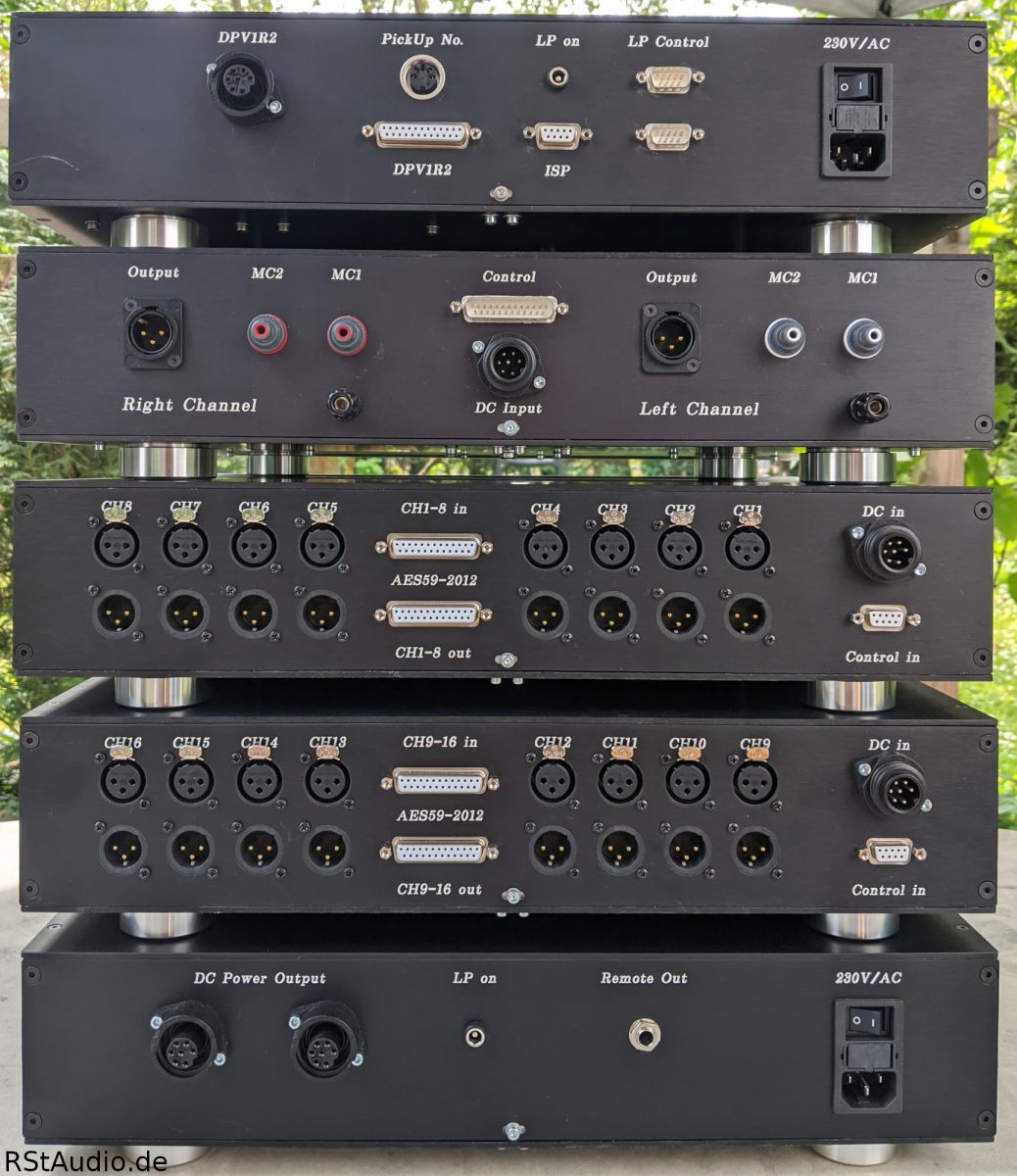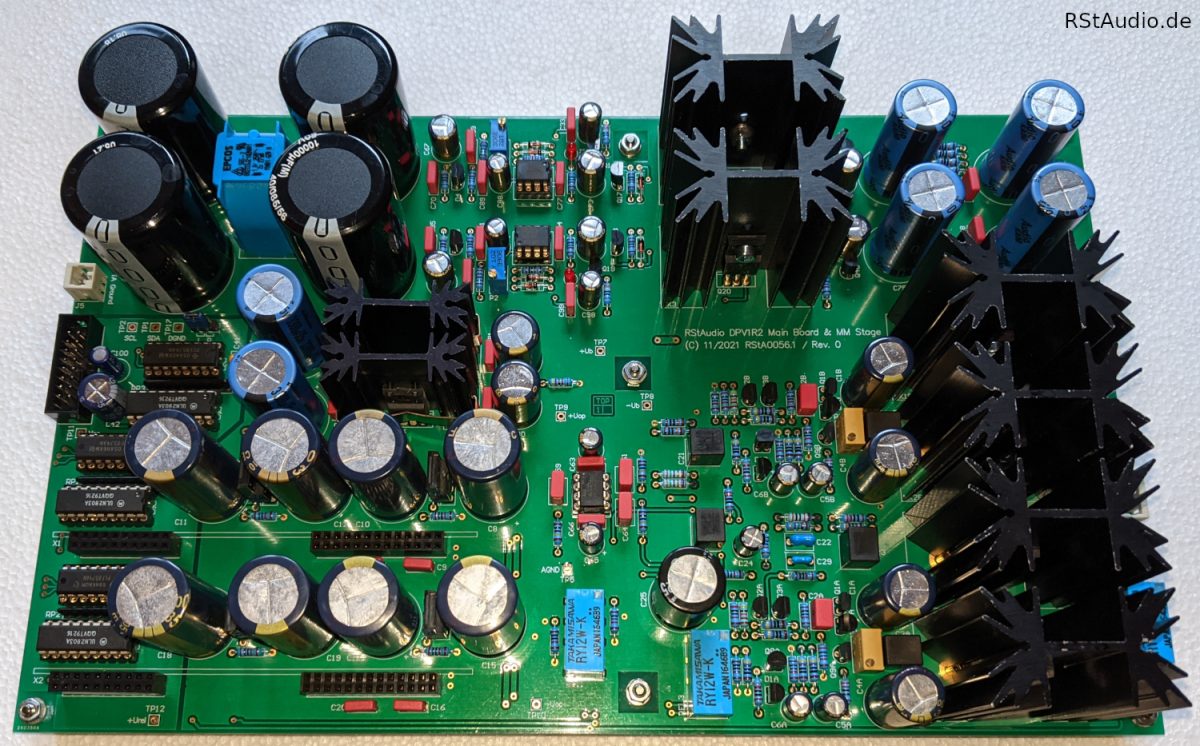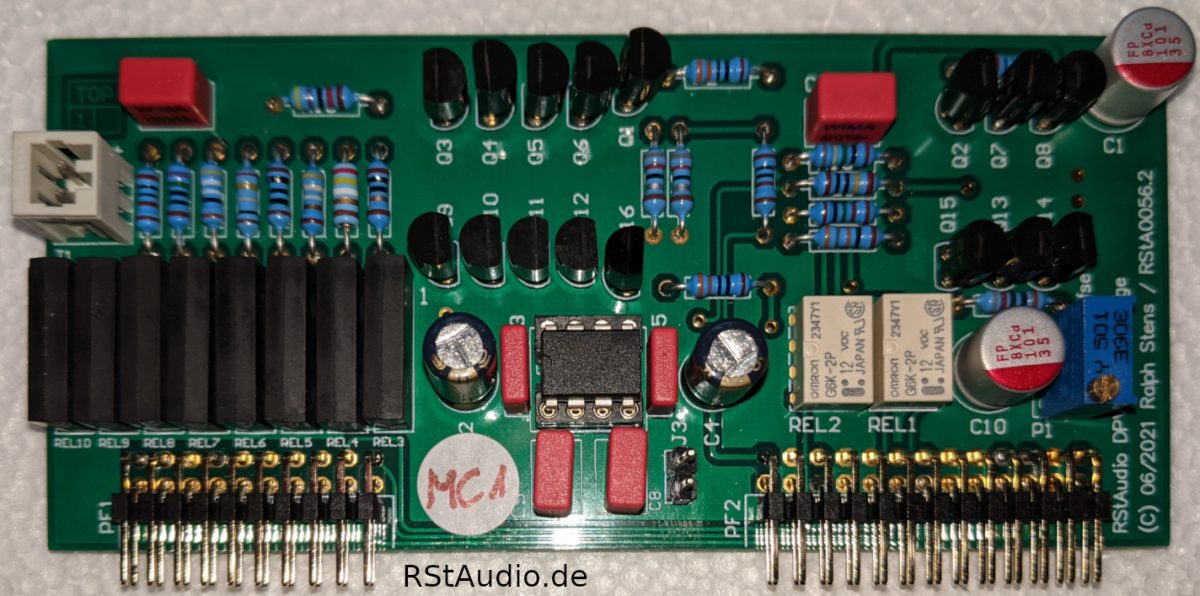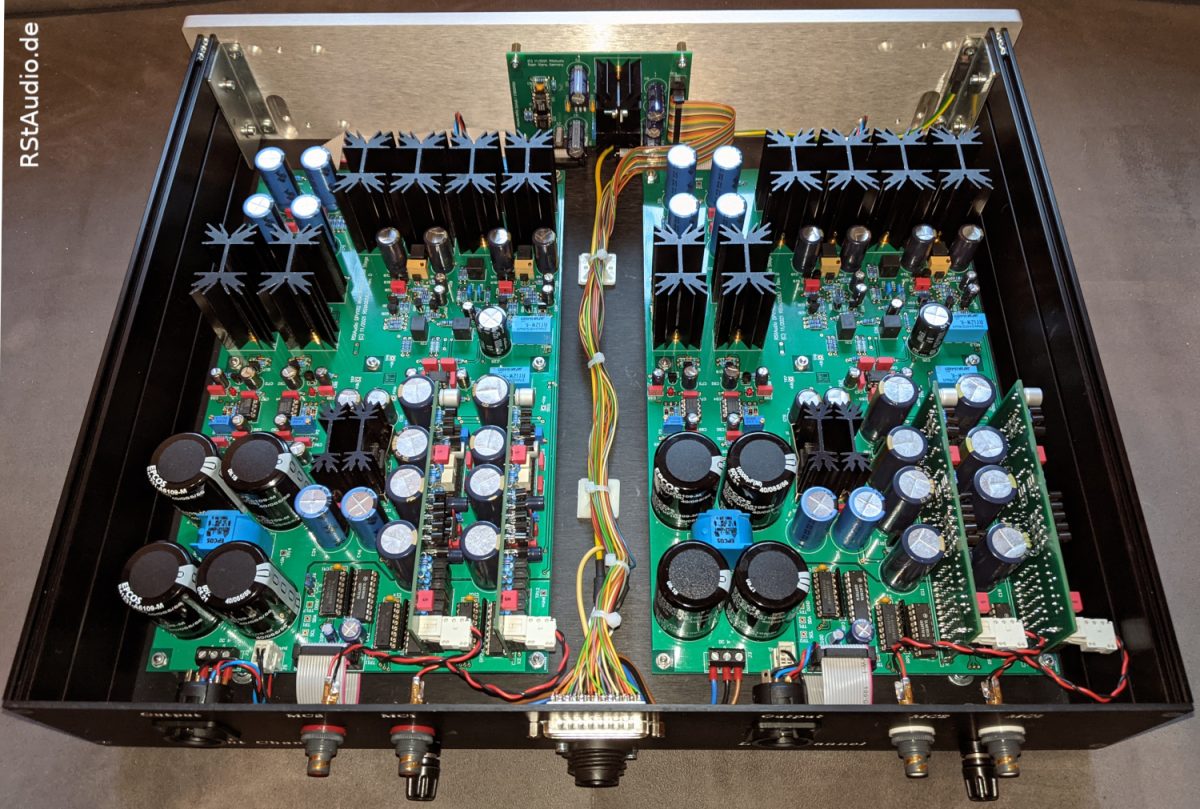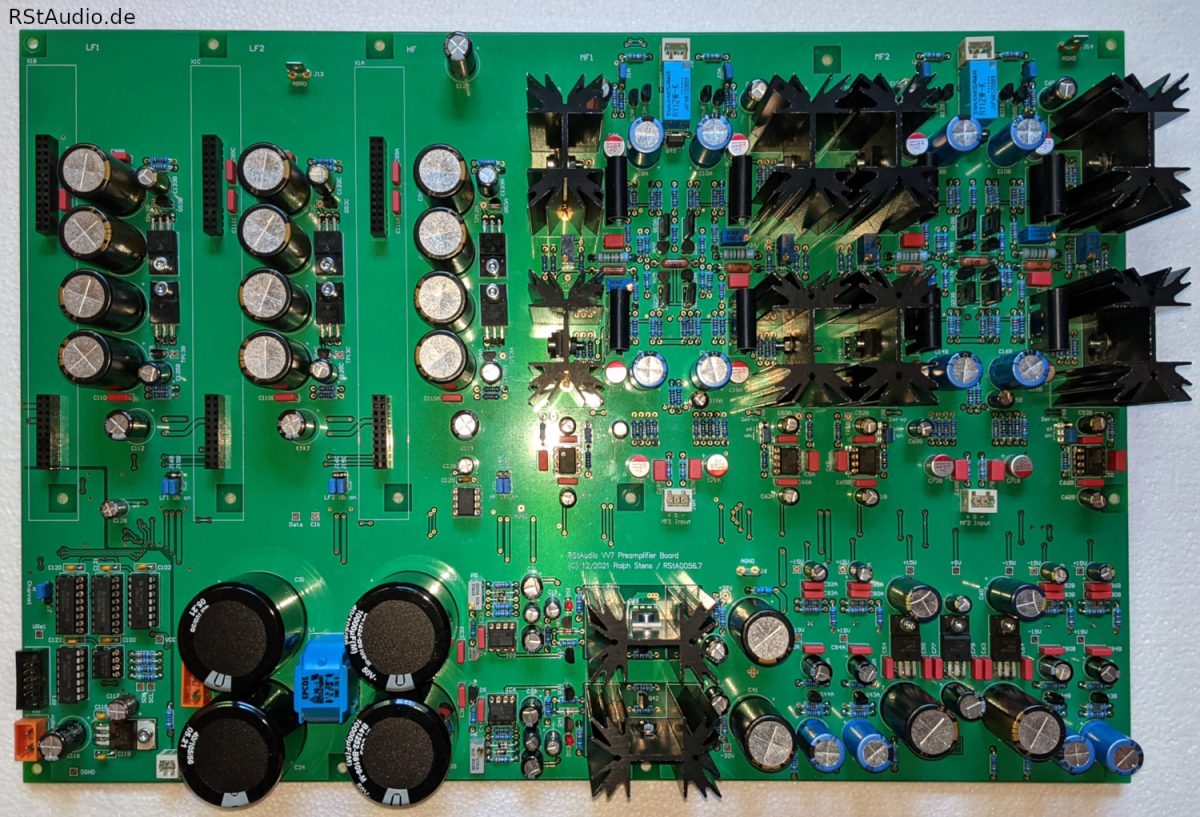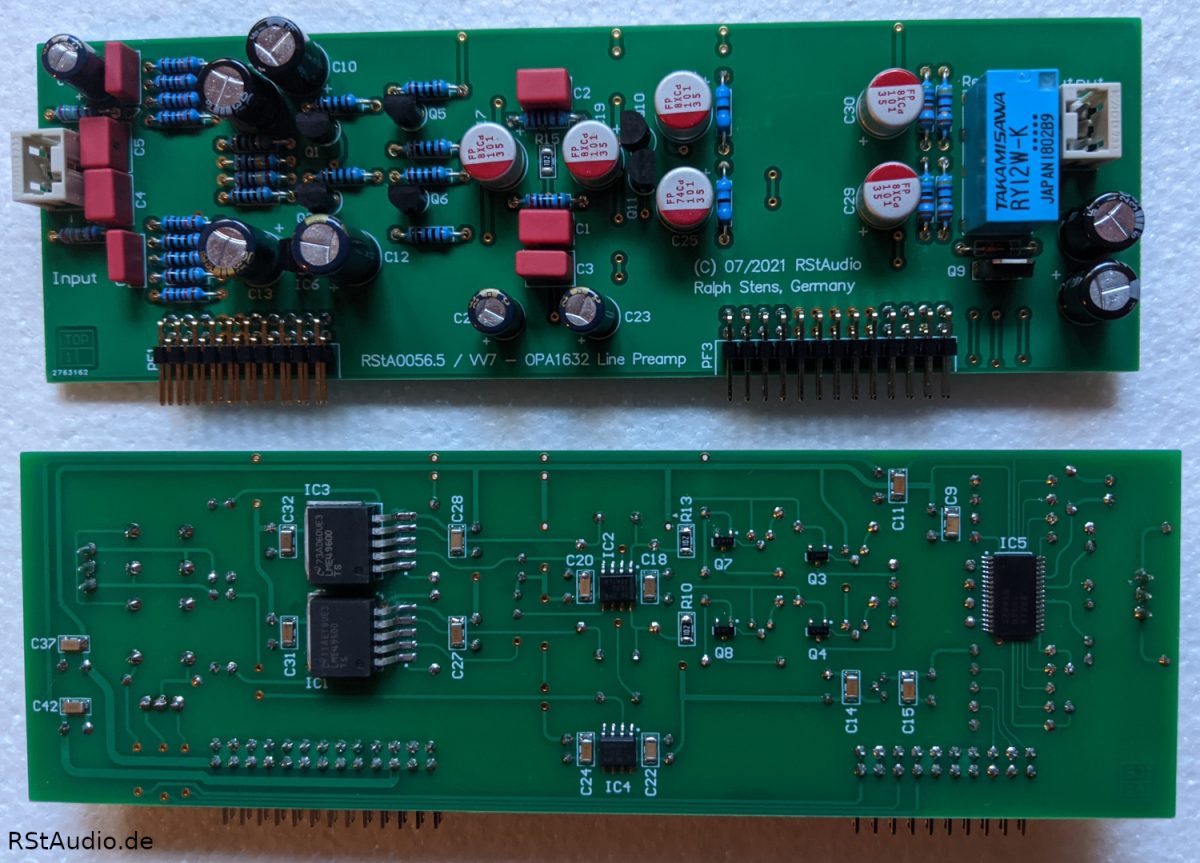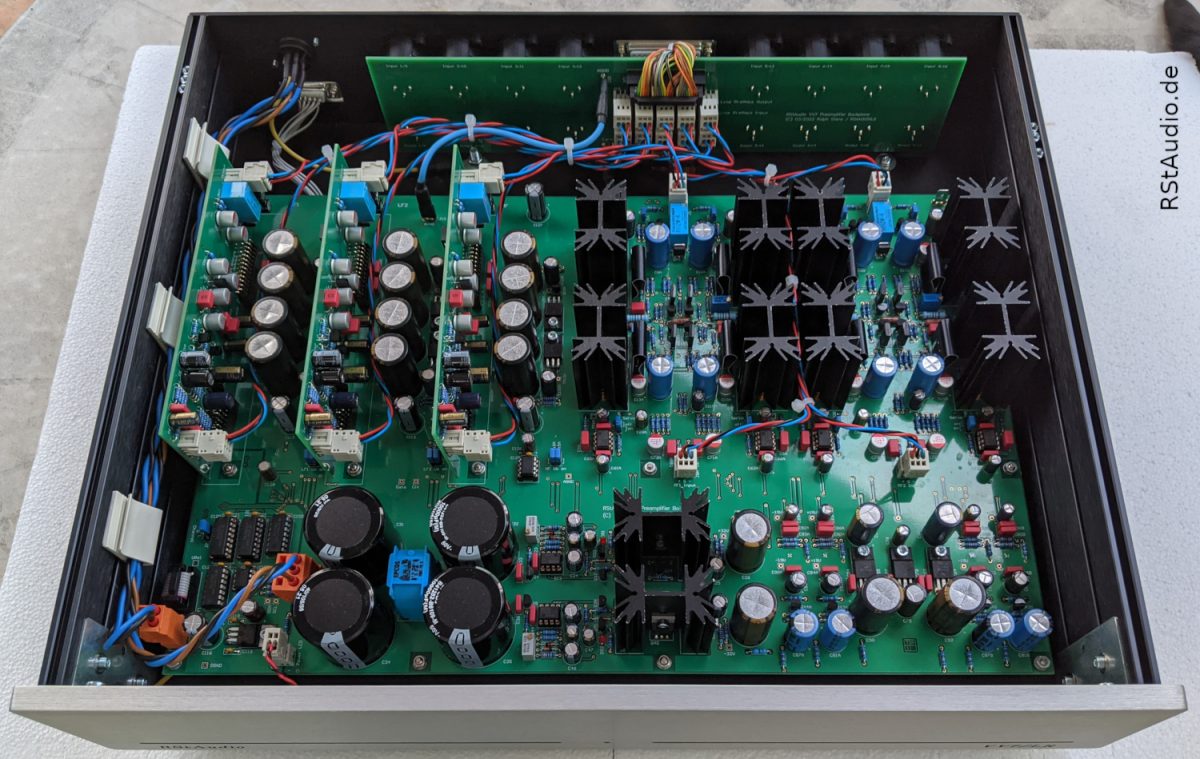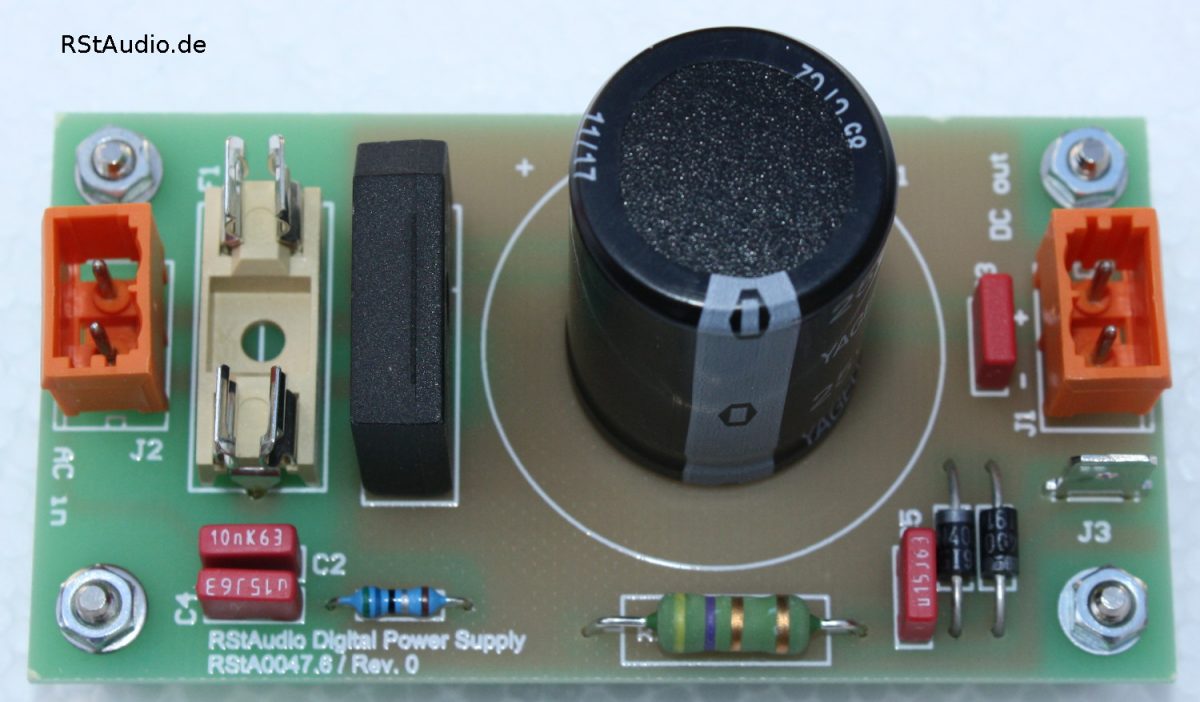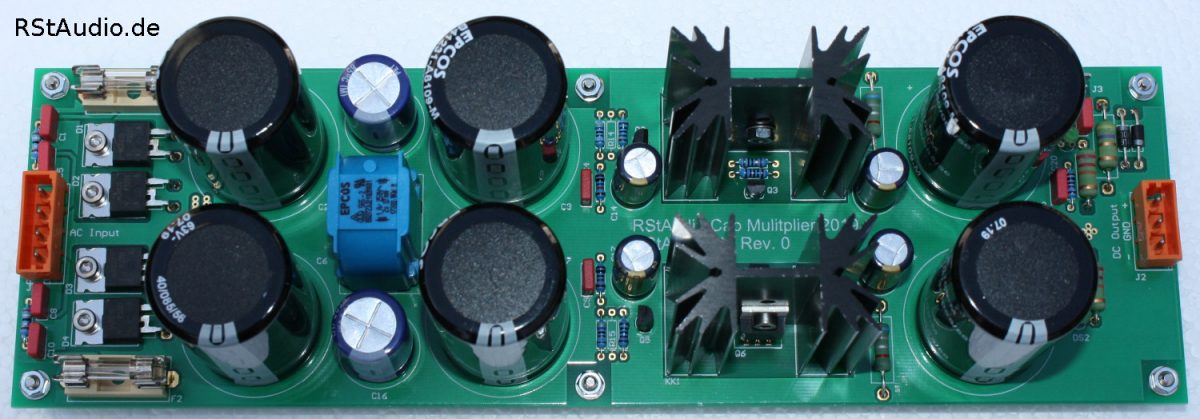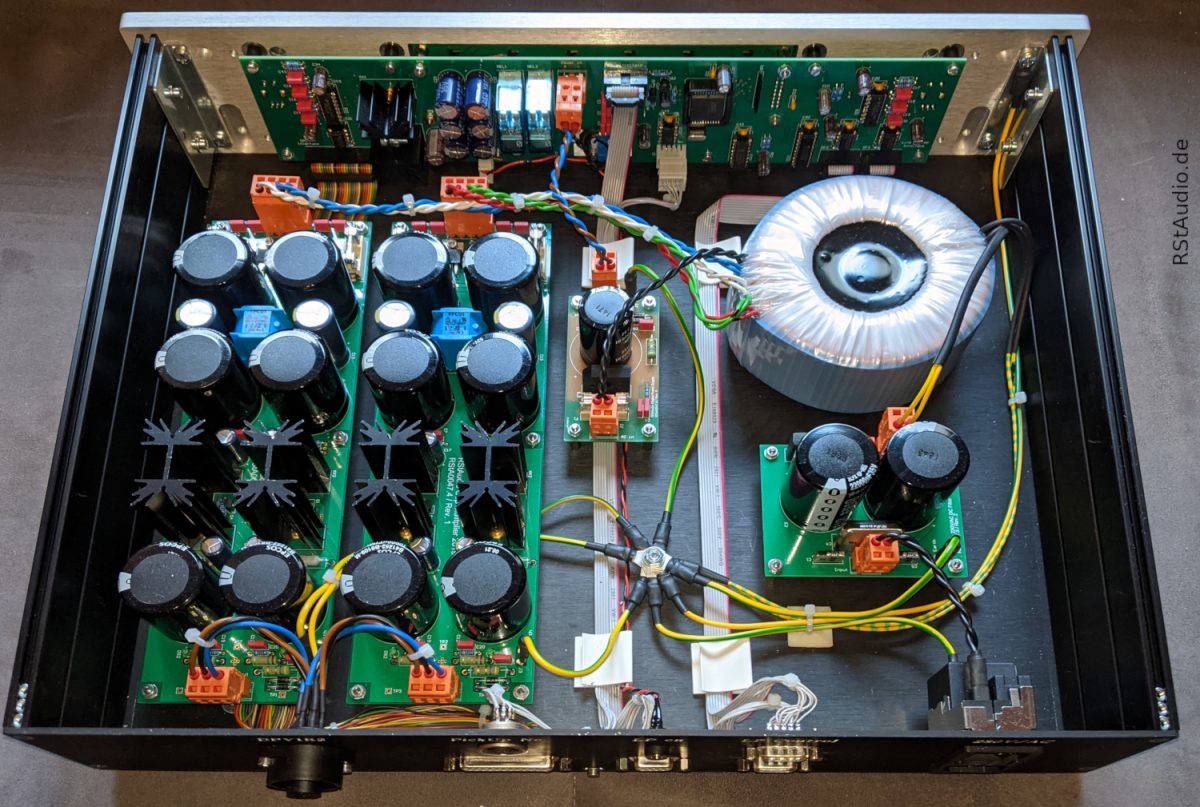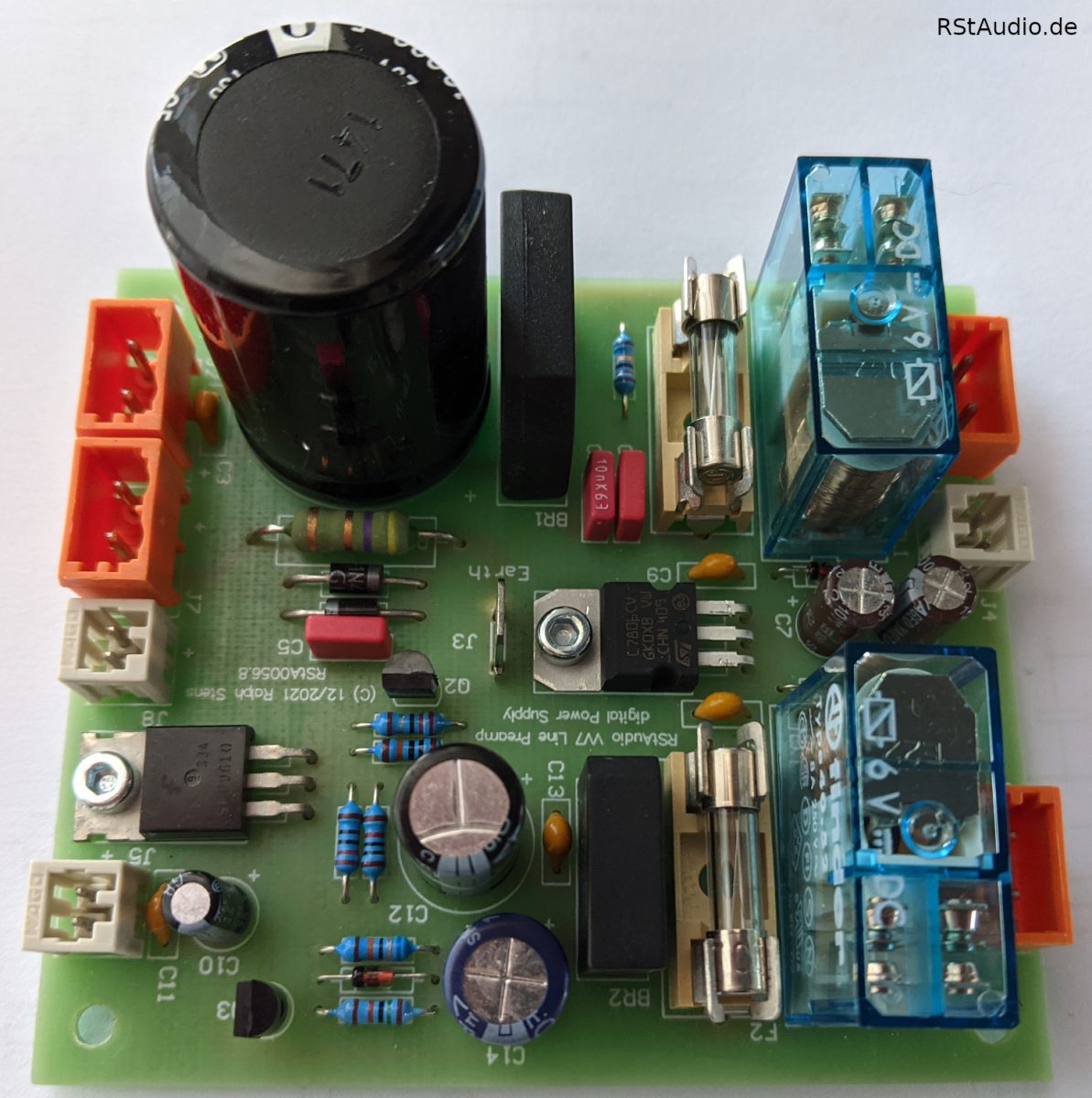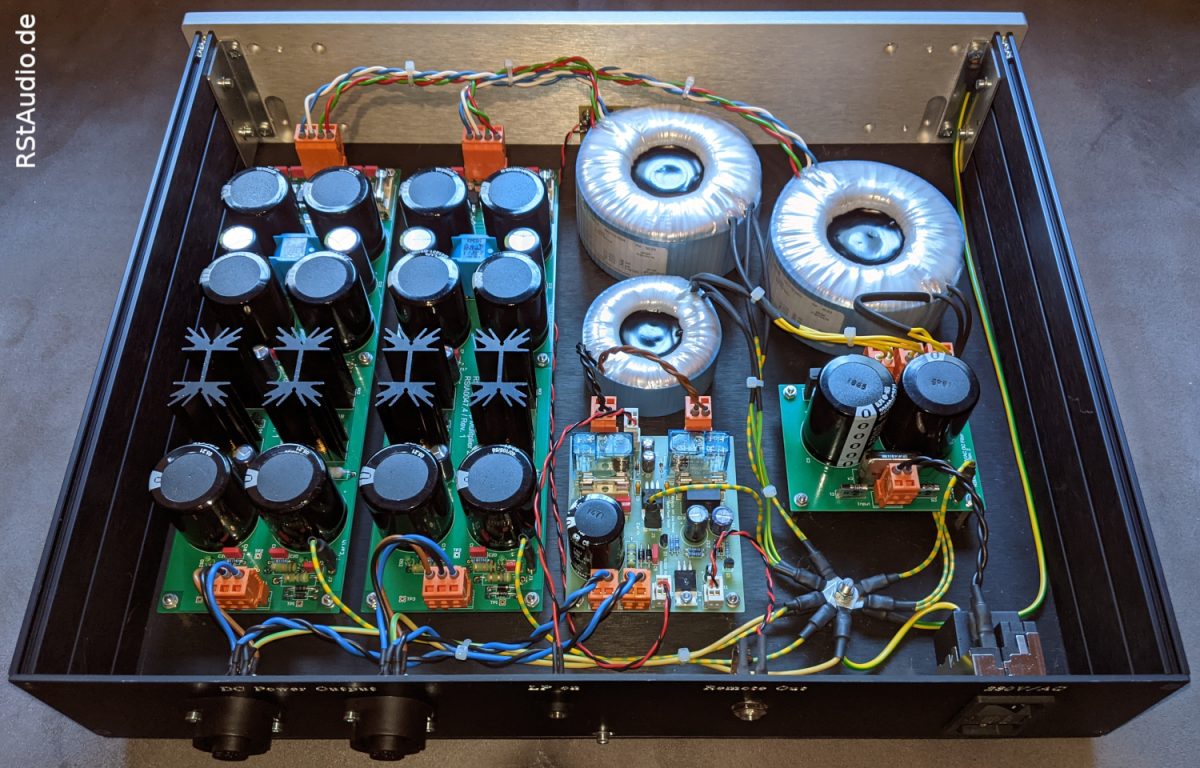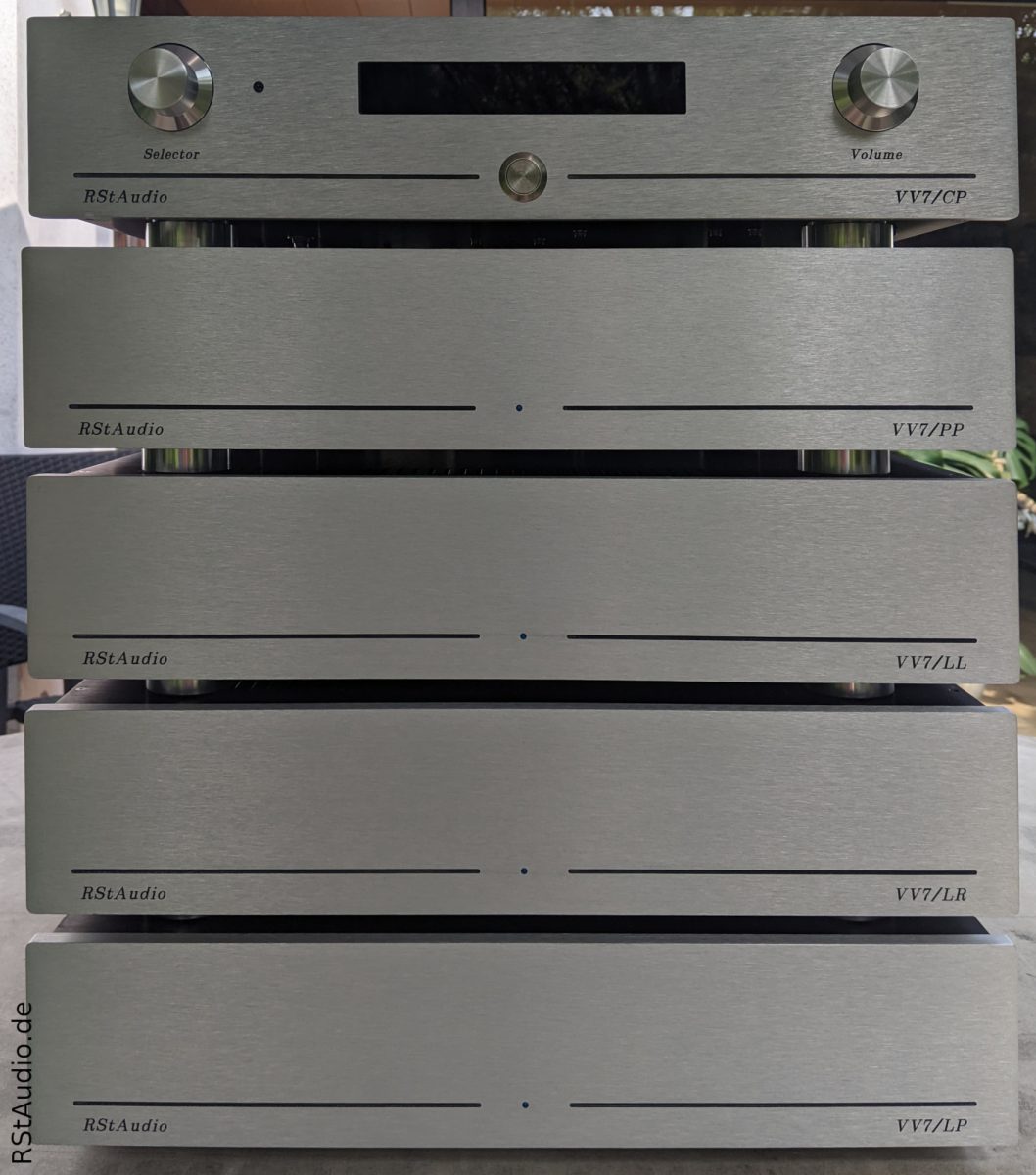
Table of Contents
- Introduction
- DPV1R2 Phono Preamplifier
- Line Preamplifier
- Controller & DPV1R2 Power Supply
- Line Preamplifier Power Supply
- Audiophile Review
Introduction
22-05-2022
In 2016/17 I built a 12 channel preamp for my friend Heiner. At that time, he had been running a system topology for many years, as have I since early 2021. At the centre of both our systems is a multi-channel A/D & D/A converter and a PC running convolution software. With such a topology, it makes sense to operate the volume setting and thus the actual preamplifier after the converter. The analogue sources are connected to the converter and the digital sources feed their signal directly into the convolution PC. The sources are then switched on the PC, usually with a tablet. Such a topology prevents the A/D converters from being undersampled at low volumes with the analogue sources and thus losing resolution. Moreover, it saves an additional D/A and A/D conversion for the digital sources.
In contrast to the VV6, however, my preamplifier should be equipped with different amplifier stages. The XC-22A line stage is still responsible for the signal processing of the Quads. In the bass and treble it is a stage in the centre of which an OPA1632 is working. All in all, it is a 2/10 channel preamplifier with 5 line stages per audio channel:
- 2x XC-22A for the Stacked Quads
- 3x OPA1632 Line Preamp in the high & low range (Mundorf Air Motion Transformer, RiPol, …)
Added to this is a phono preamplifier based on my DPV1.
All units got a common control with a microcontroller. The controller board sits in a cabinet together with the unregulated power supply for the phono modules. The line stages have their own power supply. The complete preamplifier is housed in five enclosures.
For some time now I have had a GW Instek LCR-6020 at my disposal (many thanks Guido). I used this wonderful measuring device to match the passive components that have an influence on the amplification factor or the amplitude response (frequency and/or phase) to an accuracy of ±0.1% of the nominal value. This is an extremely high effort that would not be commercially viable. This way, deviations between the channels should no longer be measurable, especially since I am also matching the semiconductors.
I have a large collection of 2SK170 / 2SJ74 which I measured years ago with a Peak Atlas DCA75 Pro. In the meantime, however, I learned that the results of the JFET measurement of this measuring device are not really convincing in the final circuit. There is simply too little current flowing during the measurement. Therefore, I re-measured all the JFET’s with the measuring device for the JFET’s of the XOno 2019. Of course, my Agilent 34401A bench multimeter was also used, a much higher quality device than the DCA75 Pro.
You learn with every project and so my devices are getting better and better, both technically and mechanically. Thanks to the front panel design of my friend Guido, the appearance has also improved considerably. My biggest self-build audio project so far.
The VV7 has been running in my system since 21-05-2022 and has replaced the VV5.2.
DPV1R2 Phono Preamplifier (VV7/PP)
22-05-2022
Since April 2018, I have been running the DPV1 phono preamplifier to my utmost satisfaction. Naturally, I wanted to incorporate this preamplifier into the VV7 design. However, after years of operation, there were also a few ideas what could be improved and so I made some changes to the design of the DPV1.
Most of these changes are rather cosmetic and ultimately have no influence on the audiophile performance of this phono preamplifier. Only the regulated power supply underwent a major revision. Instead of Pass’s discrete voltage regulators, I used the modified Jung regulator that I prefer in the meantime. Consequently, I named this phono preamplifier DPV1R2 – R2 stands for Revision 2, of course.
The DPV1R2 consists of 3 or 4 function blocks for signal processing, depending on how you want to count it. The first function block at the input is an MC preamplifier. The amplification is linear. This function block is present twice, therefore 3 or 4. A relay directly at the output of these two blocks switches between them, so there are always only 3 blocks in the active signal path. The following second function block is another amplifier stage, but with a non-linear transfer characteristic. This is where the RIAA equalisation takes place. This function block provides the positive output signal. The third block is an inverter, it generates the negative output signal for the balanced transfer technique. The input of the inverter is connected to the output of the RIAA amplifier. This phono preamplifier is only designed for MC cartridges, for an MM system the amplification in the MC preamplifier would have to be significantly reduced. However, I have personally owned only MC systems for more than 40 years, so it is not a disadvantage for me.
On the front left of the DPV1R2 board you can see the digital control of the relays. These are I2C bus port devices with subsequent open-collector Darlington drivers. You can see the separation of the two grounds (analogue & digital) very nicely.
The sockets for the two MC preamplifiers are also visible on the front left. Directly behind each socket are the extra voltage regulators (post-regulator) for the MC stages. They are installed after the main controller and supply the MC stages with approx. ±24V.
The inverter is located on the front right-hand side. It provides the negative signal of the balanced output signal. Behind it is the MM amplifier with an active 318μs and 3180μs equalisation of the RIAA curve. Additionally, the 7950μs time constant can be switched. Both amplifiers are designed as discrete operational amplifiers. The output stages have a relatively high quiescent current, which explains the very large heat sinks. Furthermore, they are driven by additional constant current sources with a “crossover displacement” circuit topology. The 75μs equalisation is passive and is located between the MC preamplifier and the MM amplifier. The 8-pin IC in the centre of the photo is a double-OP. It forms the two servo controllers for both DC-coupled discrete operational amplifiers.
The entire rear part of the PCB is occupied by the power supply unit. The unregulated operating voltage is connected on the left. A C-L-C stage with 4x 10000μF and a current-compensated double choke follows. The modified Jung regulator is connected to this. At the output there is a C-R-C filter.
The MC preamplifier has 3 stages, except for the two cascode transistors of the input stage, only n- and p-channel JFETs are used (7x 2SK170BL & 7x 2SJ74BL). There are 8 switchable resistors at the input, which can of course also be combined. Theoretically, this results in 256 possible combinations, but many values do not differ much from each other and so I have only stored practical values in the software. In addition, 4 different amplification factors can be switched. The board is DC-coupled all the way through and is kept free of DC voltage at the output by a servo controller – the operational amplifier in the picture above.
As you can see in the photo above, the housing is well filled by the two audio boards. The board behind the front panel belongs to the digital part of the DPV1R2 and distributes the control signals to the two audio boards. The digital operating voltage is also regulated here by a standard 5V regulator. The light emitting diode of the front panel is also soldered directly to the board. It is powered by an adjustable current source, so I can match the brightness to the other LEDs of the VV7. There is also a chip for measuring the internal temperature of the VV7/PP on this board.
In the centre of the rear panel are the connections for the DC supply and for the digital control. To the left and right are the audio connections. I always place the two channels as seen from the front, so the connections from the rear sides can be seen the wrong way round – i.e. right channel on the left side and vice versa. The cinch sockets of the MC inputs are from WBT, the XLR sockets of the outputs are from Neutrik.
Line Preamplifier (VV7/LL & VV7/LR)
22-05-2022
As I wrote above, this preamplifier has 2/10 channels. One audio channel consists of the two XC-22A line stages, the Jung controller, 3 slots for the additional line stages and a digital control unit for the control from the microcontroller. It is the largest circuit board, apart from the active absorber, that I have developed for any of my DIY projects so far.
Of course, as always, I use the self-construction enclosures from Italy. The amount of material used for the line stages is so large that I had to use a separate enclosure for each line stage board. But I didn’t want to compromise in any way.
The photo above shows one channel of the preamplifier. On the bottom left is the digital interface. To the right of this are the regulators of the ±32V operating voltage, the modified Jung regulator. On the right side are the voltage regulators for the two MUSES72320 and the servo controllers (±15V and +5V). At the top left you can see the three sockets for the OPA1632 boards. To the right of each are the post-regulators that generate the required ±15V from the ±32V. On the top left side you see the two XC-22A line stages. The PCB is double-sided, all SMD components are on the bottom side.
XC-22A Preamplifier
22-05-2022
This line preamp, designed by my friend Hans, surpasses everything I have heard so far – both commercially and in DIY! However, the effort is considerable and really not necessary, for example, as a preamp in the bass range. When designing the VV7, I decided to continue to supply the Quads via XC-22A line stages. Consequently, there are 2 of these preamplifiers per audio channel in the setup.
Of course, the volume is adjusted by a MUSES72320 connected in front of the respective line stage. Here, too, the ±15V operating voltage of the chip is generated from the ±32V supply with the help of the extremely low-noise integrated voltage regulators TPS7A49 / TPS7A30 from Texas Instruments. A design that has proven itself excellently in the VV5.2.
OPA1632 Preamplifier
22-05-2022
I used this balanced operational amplifier in a variety of applications for signal processing, among others with great success in the 12-channel preamplifier VV6 of my friend Heiner. Rumour has it that the chip’s design is internally super-symmetrical. In any case, this OP sounds simply stunningly good and so I decided to use it for the additional line preamps.
Of course, the excellent MUSES72320 was also set for these boards. In contrast to the VV6 design, however, I placed the OPA1632 behind the MUSES. The balanced OP has two inverting inputs, so a buffer has to be used between MUSES and OPA1632 (keyword: loaded voltage divider), otherwise you would have to work at a very high impedance around the OP, which would of course have a negative effect on the noise of the stage. I decided to use a JFET buffer with BF862, a design with an extremely neutral sound.
Behind the OPA1632 I used two LME49600 that are integrated into the OP’s negative feedback. Long supply lines to the output stages are no longer a problem. The balanced output is also kept free of DC voltage components by a servo controller.
I can deactivate the power supply of each individual plug-on board via a jumper. This saves me a few mA consumption by hardware that is not needed in the current system topology.
Backplane
22-05-2022
The two enclosures are also used to convert the 16 inputs and outputs of the Lynx Aurora(n) from the 25-pin AES59-2012 (Tascam) connectors commonly used in studio equipment to XLR. To do this, the two connections of an LM-AIO8E card go into one of the two Line PreAmp enclosures.
The 8 XLR sockets of the inputs are directly connected to the corresponding Sub-D socket. For the outputs, this is only the case for the last 3 XLR sockets (channels 6…8 and 14…16). The first 5 outputs go to five 3-pole Wago connectors that are connected to the inputs of the preamplifiers. The outputs of these preamplifiers are connected to further Wago connectors on the backplane. These are connected to the first five XLR output sockets (channel 1…5 and 9…13) on the PCB.
So everything towards my system is equipped with XLR connectors, whereas the connection between Lynx and preamplifier is made via the Tascam sockets. For this I use ready-made cables from Cordial.
The Gain Concept of the VV7
22-05-2022
As already mentioned in the introduction, the line stages of the VV7 are located behind the Lynx converter (D/A outputs). This means that the crossover, which is generated by the convolution PC, is also located in front of the line stages. This is the reason why a multi-channel preamplifier is necessary with this system topology. Currently, my “crossover” provides 7 channels – 1x mono subwoofer, 4x Quad’s and 2x Mundorf’s.
Of course, the different loudspeakers and power amplifiers do not necessarily produce the same volume level and so, with an active topology, one must also ensure a corresponding adjustment. The “fine-tuning” of this level adjustment naturally takes place in the convolver and is determined via the target curve. For a rather “coarse” presetting, the preamplifier channels themselves are used.
In the software of the VV7, an individual volume correction can be stored for each line stage. The XC-22A preamplifiers, and thus of course the Quad’s, set the basic level. Therefore, the channels for the subwoofer (RiPol) and the super tweeters (Mundorf’s) have to be adjusted to the Quad’s. This can be achieved via the software and, if necessary, via an adjusted amplification factor of the OPA1632 line stages. I also have the option of matching the Quad’s to each other.
My power amplifiers all run with a gain factor of 26dB, all preamplifier modules of the VV7 with 6dB.
Enclosure Installation
22-05-2022
As I have already written several times, the two Line PreAmp boards are each housed in their own enclosure. Due to the size of the boards, but also due to the number of connectors required, no other solution is possible. However, I am not interested in a small design, but in the implementation of all my requirements and ideas.
The photo above shows the inside of the VV7/LR from the front. The Line PreAmp circuit board pretty much fills the enclosure. The signal wiring from the backplane to the preamps is done individually with braided cables. It looks a bit messy, but it works great.
The two Tascam connectors are located slightly off-centre on the rear panel. To the left and right of them are the XLR connectors. On the right-hand side there is the socket for the DC operating voltage supply and the connection for the control signals from the VV7/CP.
Controller & DPV1R2 Power Supply (VV7/CP)
22-05-2022
I still prefer to use the AT89C51ED2 as a microcontroller to control my audio devices, as is the case here. With the help of the controller board, the VV7 is operated via 2 rotary encoders or an IR remote control and an alphanumeric OLED with 2 lines and 20 columns.
The preamplifier is switched on and off with the central button on the front panel. However, I only switch the digital components of the VV7, the analogue amplifiers are permanently supplied with operating voltage. For many years, I have found it useful to leave the audio stages of my preamplifier switched on all the time, especially the phono preamplifier. Particularly since I listen to music almost every day.
To power the controller board I use the unregulated power supply of the XOno 2019. I have this PCB in stock and there is nothing to improve on it from a current perspective.
The same applies to the power supply for the two DPV1R2 boards; here, too, I used the XOno 2019 project. The circuit technology of the unregulated analogue operating voltage is still state-of-the-art for me today. There is absolutely nothing I would improve on it.
For the supply of the phono preamplifiers I use one transformer with separate windings for the left and right channel. Even the best cartridges “only” have a channel separation of around 35dB and I easily exceed this value with the setup. At this point, channel-separated transformers are simply unnecessary. The toroidal transformer used comes, as usual, in excellent quality from Müller Elektrotechnik. In front of the transformer is a 230V/AC DC filter, again a PCB from the XOno 2019 project. Of course, I also use an integrated mains filter from Schurter at the 230V/AC input.
The picture above shows the inside view of the VV7/CP. The controller board is screwed behind the front panel. On the left side are the two circuit boards for the unregulated operating voltage for the DPV1R2 electronics. The small board in the middle generates the unregulated operating voltage for the controller. On the right side is the toroidal transformer and the 230V/AC DC filter. At the bottom right you can see the mains socket with filter from Schurter.
On the front, the two rotary encoders are located on the left and right. In the middle is the OLED and below it the button for switching the digital electronics of the VV7 on and off. To the right of the left rotary encoder you can see the IR receiver. By the way, the knobs were made by my friend Guido.
On the left of the rear panel is the socket for the DC power supply of the DPV1R2 audio electronics; I use industrial connectors from Hirschmann for this. The 25-pin Sub-D socket on the right carries the control signals and the power supply for the digital control including the relays of the phono preamplifier.
The 5-pin DIN socket PickUp No. transmits a number (4 bit binary) to the turntable’s motor electronics. This number informs the motor electronics of the selected pickup. The information is used to determine the runtime of the respective pickup (see #42 Motor Driver).
The DC socket LP on carries a control signal with which the unregulated power supply for the digital electronics of the line preamplifier in the VV7/LP is switched on and off. The controller is programmed via the 9-pin Sub-D socket ISP (see Flip). The two 9-pin Sub-D connectors LP Control on the right carry the control signals for the two line stages (VV7/LL & VV7/LR).
On the outside right is the mains socket with fuses, switch and mains filter from Schurter.
Line Preamplifier Power Supply (VV7/LP)
22-05-2022
This enclosure houses the unregulated operating voltages for the two line preamp boards. For the analogue voltages, I also used the XOno 2019 project (see above).
I expanded the unregulated supply of the digital circuit based on the design of the XOno 2019 project. I added a circuit section with which I can switch the digital supply on and off from the controller. In addition, my Remote Out control is integrated. As before, my entire system is to be switched on and off via the preamplifier. Here, too, the analogue line level remains permanently supplied.
In contrast to the VV7/CP, I use separate toroidal transformers at this point, of course again from Müller Elektrotechnik. There is a 130VA transformer each for the supply of the left and right audio electronics and a 23VA transformer for the digital electronics. More than enough power and, as always, oversized, which is how I prefer it.
The photo above shows the inside view. On the left sit the two boards for the supply of the analogue circuit parts of the line stages, also at this point the unregulated power supplies described above from the XOno 2019 project. In the centre front the above described PCB with the digital supply is placed. To the right of this sits the 230V/AC DC filter. The rest of the space is filled by the three toroidal transformers.
The rear panel of the VV7/LP is rather simple. On the left you can see the two Hirschmann sockets, they carry the analogue and digital power supply for one line stage each (VV7/LL & VV7/LR). The socket labelled “LP on” supplies a control voltage from the VV7/CP that switches the digital circuitry of the line stages on and off. “Remote Out” carries the control voltage for switching the rest of my system on and off. The Schurter mains socket can be seen on the far right.
Audiophile Review
24-03-2022
DPV1R2
The phono preamplifier played impressively well right after the first switch-on. It benefits more than expected from the Jung regulators. My decision to make the effort for a Rev. 2 was definitely right.
22-05-2022
The VV7 went into operation today at my system. I will now first listen intensively for a while and then make an assessment. I don’t use any new components, so it will primarily be an evaluation of the changed topology.
01-08-2022
DPV1R2
What I wrote above has been confirmed, the DPV1R2 has benefited more than expected from the power supply (modified Jung regulator). With this power supply, the DPV1R2 is at the top of all phono preamps I have heard so far, whether commercial or DIY.
Line PreAmp
I had expected that no major audiophile changes compared to the VV5.2 would occur, but that is not the case! I still think that if you look at the stages individually there will be no real difference, but the changed topology has done my system more than expected good. If one operates a system like mine, one must also use a multi-channel preamplifier, everything else would have gone only half way.
I am extremely satisfied with the overall result and the subject of preamplifiers is completed for me (for now).
